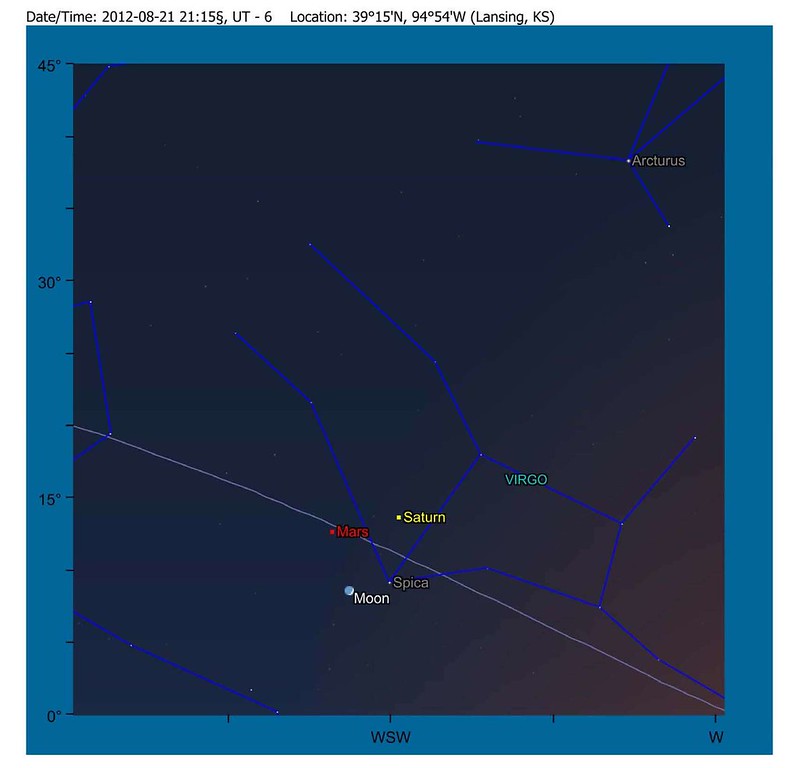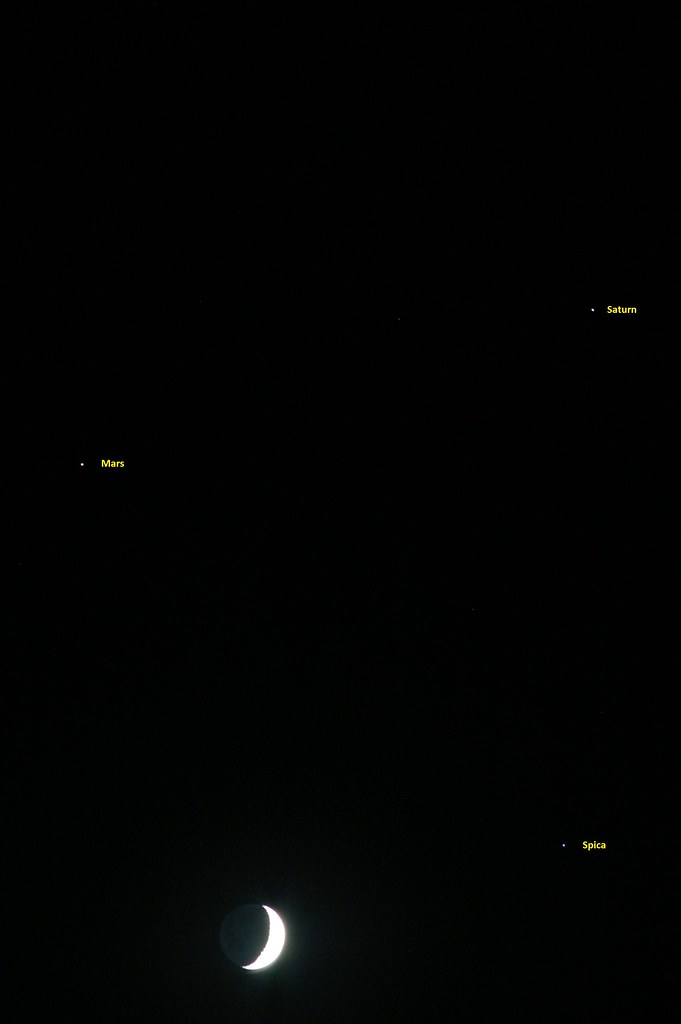Head scratching math paradox as an appetizer before dinner this evening.
Enjoy!
Posted from WordPress for Android via my Samsung smartphone. Please excuse any misspellings. Ciao, Jon
Sunsets, Stars, West, Wind
Head scratching math paradox as an appetizer before dinner this evening.
Enjoy!
Posted from WordPress for Android via my Samsung smartphone. Please excuse any misspellings. Ciao, Jon
I put an appointment on my calendar earlier this week with an alert to remind me to go chasing planets after sunset on Tuesday evening. I make sure to check Astronomy and Sky & Telescope magazines’ websites for their ‘The Sky This Week’ observing articles and place the interesting (and observable from my location) items on my calendar. Here’s the paragraph for Tuesday evening from Astronomy’s web site:
 Tuesday, August 21 – Our trio of bright evening objects — Saturn, Mars, and Spica — forms a pretty equilateral triangle (5° on a side) in the southwestern sky after sunset. But the highlight of the scene tonight is a gorgeous crescent Moon that hangs just 4° below Mars. Binoculars provide the best view of this celestial gathering. Look closely and you’ll notice the objects’ different colors. The Moon’s color depends largely on conditions in Earth’s atmosphere and could be anywhere from white (under a dry, haze-free sky) to yellow or even slightly orange. Sunlight reflecting off Saturn’s clouds has a golden glow while Mars’ ruddy deserts cast an orange hue. Blue-white Spica generates its own light from a scorching surface nearly four times hotter than the Sun’s.
Tuesday, August 21 – Our trio of bright evening objects — Saturn, Mars, and Spica — forms a pretty equilateral triangle (5° on a side) in the southwestern sky after sunset. But the highlight of the scene tonight is a gorgeous crescent Moon that hangs just 4° below Mars. Binoculars provide the best view of this celestial gathering. Look closely and you’ll notice the objects’ different colors. The Moon’s color depends largely on conditions in Earth’s atmosphere and could be anywhere from white (under a dry, haze-free sky) to yellow or even slightly orange. Sunlight reflecting off Saturn’s clouds has a golden glow while Mars’ ruddy deserts cast an orange hue. Blue-white Spica generates its own light from a scorching surface nearly four times hotter than the Sun’s.
∞ ∞ ∞
Terry and Sean had retreated to the band room for rehearsal and I sat slogging my way through the 49th Parallel, a British WWII film released in the United States under the title The Invaders. I recorded it a couple of weeks ago off the TCM channel. It drags and I still haven’t finished it. So when my phone buzzed with the text message alert, I jumped, literally, at the chance to stop watching the film and start looking up at the sky.
I took my camera gear and got in the van. I couldn’t take the Bonneville because Sean’s car happened to be parked in front of the garage. I didn’t mind taking the van; it’s what I drive every weekday anyway. I left the house at 8:20, about fifteen minutes after sunset, so the western sky still shown with twilight. I could clearly see the bright waxing crescent moon, but could not yet see Saturn, Mars or Spica. I drove west and southwest from Lansing, trying to find a spot clear of trees on top of a hill to setup the camera.
 I ended up driving almost an hour all over the middle of Leavenworth County and even through the small unincorporated town of Jarblo. I never did find a satisfactory location. I finally stopped in the parking lot of the High Prairie Church at the corner of 187th street and the end of Eisenhower Road. The church had blazing bright lights illuminating their building, but I parked far away at the north end of the parking lot and used the van as a shield. I took several photos with various settings for about ten to fifteen minutes. I took a few minutes to just look around at the night sky from this location, liking the clear 360 degree visibility (lack of trees and less light pollution, if you didn’t look towards the church building). I could clearly see the constellations Scorpius, Sagittarius, Cassiopeia, Ursa Major, but still only about half the stars in Ursa Minor. I could not yet see Pegasus as it still needed another hour or two to rise out of the east.
I ended up driving almost an hour all over the middle of Leavenworth County and even through the small unincorporated town of Jarblo. I never did find a satisfactory location. I finally stopped in the parking lot of the High Prairie Church at the corner of 187th street and the end of Eisenhower Road. The church had blazing bright lights illuminating their building, but I parked far away at the north end of the parking lot and used the van as a shield. I took several photos with various settings for about ten to fifteen minutes. I took a few minutes to just look around at the night sky from this location, liking the clear 360 degree visibility (lack of trees and less light pollution, if you didn’t look towards the church building). I could clearly see the constellations Scorpius, Sagittarius, Cassiopeia, Ursa Major, but still only about half the stars in Ursa Minor. I could not yet see Pegasus as it still needed another hour or two to rise out of the east.
I packed up the camera gear and headed home, using Eisenhower Road to get back to Lansing. I parked the van, noting that Sean’s car still sat in the driveway. I returned to the living room, unpaused the 49th Parallel and again attempted to finish the film. Within five minutes, Terry and Sean came upstairs and Sean said his goodbyes. I asked Terry if he had even noticed that I’d been gone for an hour. He had that ‘deer in the headlights’ look that answered my question well enough.
I stopped my feeble attempt to finish the movie and instead switched to the season premiere of Top Gear, an episode featuring a battle between the three big American auto makers to produce a successor to the reigning but retiring police vehicle of choice: the Ford Crown Victoria. The Stig, driving a minivan, managed to evade all three Crown Vics, shaming the hosts (and the cars they were driving). That initial segment ended in a free-for-all demolition derby of the retiring behemoths. I made sure to Tweet the abuse to a friend who still owns (and loves) his Crown Victoria.
By the time we finished watching Top Gear, I realized I was up way past my bedtime. I retreated upstairs and crashed.
∞ ∞ ∞
I hit the snooze button a couple of times this morning, not happy at all with the shortened sleep. I made a strong pot of Irish Blend tea to take with me during the morning commute so I wouldn’t nod off and disrupt my riders with an accident or off-road excursion. I did remember to grab my camera’s memory card so I could download and review the photos I’d taken the previous evening.

I re-read the paragraph on the Astronomy.com web page and decided to test the equilateral triangle theory on my photos of Mars-Saturn-Spica. I used a nice clear plastic ruler to measure, on my laptop screen, the distance in centimeters between the three corners of the triangle. The distance between Saturn and Spica and Saturn and Mars appeared to be identical. But the distance between Mars and Spica was greater by 1.5 to 2 centimeters. So, technically, my photo did not confirm the observation of an imaginary equilateral triangle. Perhaps earlier in the day (or even the previous day), Mars might have been in the exact position to be equidistant visually from Saturn and Spica, but not last night at a quarter past nine o’clock.
I still hope to net Neptune this weekend, but my chances are looking slim. The weather forecast for the next few days includes thunderstorms. Ironic, that, since my next night to volunteer at Powell Observatory is this coming Saturday. This would be my third night of the public season, and if overcast, would make it two out of three times cloudy.
Sunday afternoon became more distracting as it approached evening. Aside from the numbness and tingling which reasserts itself every few minutes, I find it difficult to count stitches and determine multiples of double digit numbers in my head while remembering the end goal of max stitches for that row all while the rest of the family watches a movie or taunts the Rotts into playing boisterously.
At row fifteen, I stopped and took a break for a bit. I read a few pages in Grand Conspiracy. I then found a piece of paper to write out the next seven rows numerical stitch pattern. For example, until row twenty-two, I need to increase each row by adding six stitches evenly spaced around the round. I wrote the following quick chart to aid in my stitch counting:
| Row | x2 | x3 | x4 | x5 | x6 |
| 16 | 32 | 48 | 64 | 80 | 96 |
| 17 | 34 | 51 | 68 | 85 | 102 |
| 18 | 36 | 54 | 72 | 90 | 108 |
| 19 | 38 | 57 | 76 | 95 | 114 |
| 20 | 40 | 60 | 80 | 100 | 120 |
| 21 | 42 | 63 | 84 | 105 | 126 |
| 22 | 44 | 66 | 88 | 110 | 132 |
I made it to row eighteen last night before retiring to bed.

Part of the reason I enjoy crocheting, or music (which is tangential I know) has to do with all the finite math involved with the patterns. And the best part of all, at least when working a circular crochet pattern is the chance to use my favorite mathematical constant. Stretch your memory back to the days of algebra and geometry and remember the simple formula for determining the circumference of a circle:

Can’t remember? Well, let me remind you using the photo above. If the diameter of a circle is 10.25 inches, the circumference is the diameter multiplied by the constant pi:
C = dπ
Or, as illustrated above:
C = 10.25 * 3.14159
C = 32.2
I have four more rows of increasing before I crochet a band of a half dozen single crochets (with no increases in stitches). After that, I start decreasing. The pattern reduces to a head band circumference of 18.25 inches, which is too small for Rachelle’s inflated ego, er I mean head. Her cranium has a circumference of over 22 inches. So I’ll have to do yet more math to determine the proper stopping point during the reduction.
I’ve decided not to take this Brimmed Cap project with me to work today, even though with the vanpool I have over an hour I could be crocheting to and from work. Mondays (and Fridays) I usually have to tote quite a few things with me (like a week’s worth of lunches and a laptop). If I don’t finish the cap this evening, I’ll probably take it with me on the commute Tuesday.